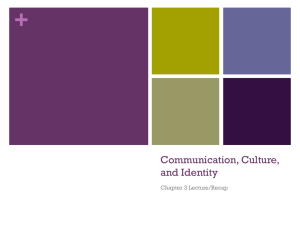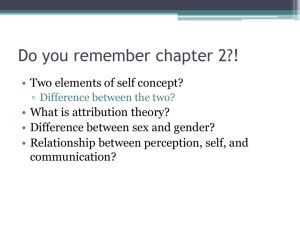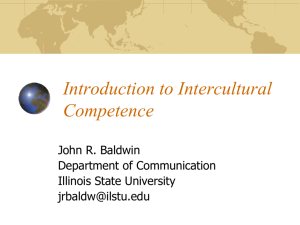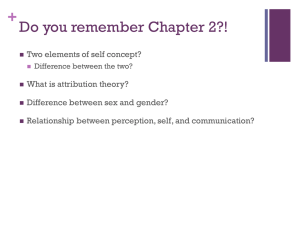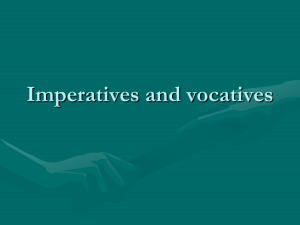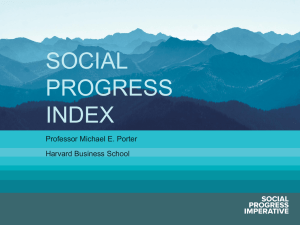IMPERATIVES for the Study of Intercultural
advertisement
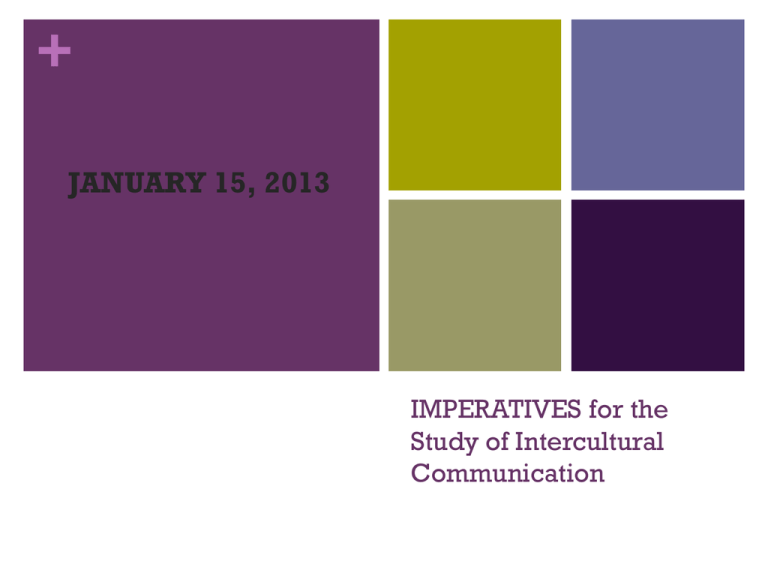
+ JANUARY 15, 2013 IMPERATIVES for the Study of Intercultural Communication + IMPERATIVE—what’s that? Something is imperative when it is very important—but not just very important, but important enough to provide a sort of “authoritative command.” In other words, something is important enough that it makes it urgent that we respond to what we are aware of So, when Martin & Nakayama say they have selected “six imperatives” for the study of intercultural communication, what does that mean? It means that + So why Intercultural and not just “plain” Communication? Obviously, there’s something about these six imperatives that implies that there’s importance about the communication that occurs NOT just between one person and his/her own thoughts and ideas (self-talk) NOT just between co-workers or neighbors who have a lot in common at stake because of what they do or where they live NOT just between friends or lovers or spouses or family members…who care so deeply about each other that conflict can cause a sense of personal threat or loss BUT between persons who are of different cultures—so that the communication is occuring between (INTER) cultures—requiring that different assumptions for how to make meaning are operating. + But isn’t ALL communication “Intercultural?” That’s a good point. It’s possible, and actually, quite real, that people vary in the way they make sense of things. But when we call something a “culture” more formally, we are talking about whole systems of sense-making and ordering of society and perception that are shared by individuals because of some sort of group membership they hold in common and which is a very strong influence in how they interact with others. When communication is intercultural, we’ve got parties of two different groups who have significant differences in the ways they view at least a few things that matter to them—and those differences influence the way they can understand and/or cooperate with others who don’t share them. + The Six Imperatives Named by Martin & Nakayama Self-Awareness Imperative (as we come to understand how we fit or operate in the greater world and realize things about our personal ways of making sense and interpreting the world) Demographic Imperative: changing domestic and international migration, as well as birth rates and patterns of intermarriage—raising questions of class, and religious diversity, age-related customs and patterns, tradition, etc. Economic Imperative: issues of globalization (how the world is becoming a smaller place—we’re more interconnected to the rest of the world, needing to depend upon each other to survive and thrive economically. + The Six Imperatives Named by Martin & Nakayama (cont’d) Technological Imperative: increased use of communication technology also raises questions about identity and access to these technologies, as well as making increasing amounts of information about an increasing amount of topics and peoples available to everyone with technological access. Peace Imperative: This imperative becomes important as we realize how issues of colonialism, economic disparities, and racial, ethnic, and religious differences can be the cause of violence and strife, war and political impasses. Ethical Imperative: This imperative calls for an understanding of the variety of ways that individuals can approach what they consider to be right or real. + Ethical Approaches Universalist—when a culture has a universalist approach, what does it assume? Relativist—similarly, when a culture has a relativist approach, what is assumed? Dialogic—Finally, when there is a “dialogic” approach, what is assumed? Consider that when one has an “ethical” approach, it tells us something about the way they proceed to consider how they should act, and not only that—but how they should judge how others act. It is about what guides their actions to be right and just. Is it possible to have more than one ethical approach? How? When? + Reference These notes are derived from the material in Martin & Nakayama’s 5th edition of Intercultural Communication in Contexts, with commentary and perspective provided by Dr. Sarah Amira de la Garza. Spring, 2013 Arizona State University +
